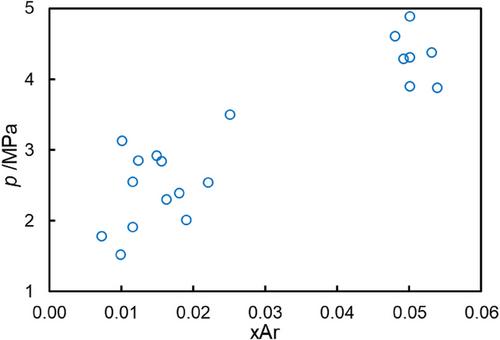下载PDF
{"title":"不可冷凝的 CCUS 杂质(CH4、O2、Ar 和 N2)对富二氧化碳二元体系在低温(228.15-273.15 K)下的饱和特性(气泡点)的影响","authors":"Franklin Okoro, Antonin Chapoy, Pezhman Ahmadi, Rod Burgass","doi":"10.1002/ghg.2252","DOIUrl":null,"url":null,"abstract":"<p>The present work investigated the effects of some non-condensable impurities (i.e., N<sub>2</sub>, O<sub>2</sub>, CH<sub>4</sub>, and Ar) on the phase behaviour of CO<sub>2</sub>-rich systems at low temperature conditions (228.15–273.15 K). The study focused on bubble point measurements of CO<sub>2</sub>-rich systems using the isothermal (pressure–volume) method at different mole fractions of CO<sub>2</sub> (99.5%–95%). The obtained experimental data were used to validate multi-fluid Helmholtz energy approximation (MFHEA) and Peng–Robinson (PR) equations of state (EoSs). For all data points, the measurements’ uncertainties for temperature and pressure were 0.14 K and 0.03 MPa, respectively. While the composition uncertainty of the CO<sub>2</sub> systems was a maximum of 0.024%. The findings reveal that as the mole fractions of the impurities increased, the bubble point pressures of the binary mixtures were elevated. Among all the investigated impurities, N<sub>2</sub> has the most significant effect on the bubble point pressures of CO<sub>2</sub> binary mixture at all the isotherms and compositions. Both MFHEA and PR models agreed well with the measured equilibrium points. For all systems, the average absolute deviations of the measured experimental data against the MFHEA and PR EoSs, were found to be less than 3.4% and 2.2%, respectively. Although the MFHEA EoS overpredicted most of the data points, the overall trend agreed with the experimental data and was consistent with the data available in the literature. The findings imply that the presence of these non-condensable impurities (even as low as 0.5% mole fraction) increases the risk of two-phase flow at higher pressures in a CO<sub>2</sub>-rich system. © 2023 The Authors. <i>Greenhouse Gases: Science and Technology</i> published by Society of Chemical Industry and John Wiley & Sons Ltd.</p>","PeriodicalId":12796,"journal":{"name":"Greenhouse Gases: Science and Technology","volume":"14 1","pages":"62-94"},"PeriodicalIF":2.7000,"publicationDate":"2023-12-26","publicationTypes":"Journal Article","fieldsOfStudy":null,"isOpenAccess":false,"openAccessPdf":"https://onlinelibrary.wiley.com/doi/epdf/10.1002/ghg.2252","citationCount":"0","resultStr":"{\"title\":\"Effects of non-condensable CCUS impurities (CH4, O2, Ar and N2) on the saturation properties (bubble points) of CO2-rich binary systems at low temperatures (228.15–273.15 K)\",\"authors\":\"Franklin Okoro, Antonin Chapoy, Pezhman Ahmadi, Rod Burgass\",\"doi\":\"10.1002/ghg.2252\",\"DOIUrl\":null,\"url\":null,\"abstract\":\"<p>The present work investigated the effects of some non-condensable impurities (i.e., N<sub>2</sub>, O<sub>2</sub>, CH<sub>4</sub>, and Ar) on the phase behaviour of CO<sub>2</sub>-rich systems at low temperature conditions (228.15–273.15 K). The study focused on bubble point measurements of CO<sub>2</sub>-rich systems using the isothermal (pressure–volume) method at different mole fractions of CO<sub>2</sub> (99.5%–95%). The obtained experimental data were used to validate multi-fluid Helmholtz energy approximation (MFHEA) and Peng–Robinson (PR) equations of state (EoSs). For all data points, the measurements’ uncertainties for temperature and pressure were 0.14 K and 0.03 MPa, respectively. While the composition uncertainty of the CO<sub>2</sub> systems was a maximum of 0.024%. The findings reveal that as the mole fractions of the impurities increased, the bubble point pressures of the binary mixtures were elevated. Among all the investigated impurities, N<sub>2</sub> has the most significant effect on the bubble point pressures of CO<sub>2</sub> binary mixture at all the isotherms and compositions. Both MFHEA and PR models agreed well with the measured equilibrium points. For all systems, the average absolute deviations of the measured experimental data against the MFHEA and PR EoSs, were found to be less than 3.4% and 2.2%, respectively. Although the MFHEA EoS overpredicted most of the data points, the overall trend agreed with the experimental data and was consistent with the data available in the literature. The findings imply that the presence of these non-condensable impurities (even as low as 0.5% mole fraction) increases the risk of two-phase flow at higher pressures in a CO<sub>2</sub>-rich system. © 2023 The Authors. <i>Greenhouse Gases: Science and Technology</i> published by Society of Chemical Industry and John Wiley & Sons Ltd.</p>\",\"PeriodicalId\":12796,\"journal\":{\"name\":\"Greenhouse Gases: Science and Technology\",\"volume\":\"14 1\",\"pages\":\"62-94\"},\"PeriodicalIF\":2.7000,\"publicationDate\":\"2023-12-26\",\"publicationTypes\":\"Journal Article\",\"fieldsOfStudy\":null,\"isOpenAccess\":false,\"openAccessPdf\":\"https://onlinelibrary.wiley.com/doi/epdf/10.1002/ghg.2252\",\"citationCount\":\"0\",\"resultStr\":null,\"platform\":\"Semanticscholar\",\"paperid\":null,\"PeriodicalName\":\"Greenhouse Gases: Science and Technology\",\"FirstCategoryId\":\"93\",\"ListUrlMain\":\"https://onlinelibrary.wiley.com/doi/10.1002/ghg.2252\",\"RegionNum\":4,\"RegionCategory\":\"环境科学与生态学\",\"ArticlePicture\":[],\"TitleCN\":null,\"AbstractTextCN\":null,\"PMCID\":null,\"EPubDate\":\"\",\"PubModel\":\"\",\"JCR\":\"Q3\",\"JCRName\":\"ENERGY & FUELS\",\"Score\":null,\"Total\":0}","platform":"Semanticscholar","paperid":null,"PeriodicalName":"Greenhouse Gases: Science and Technology","FirstCategoryId":"93","ListUrlMain":"https://onlinelibrary.wiley.com/doi/10.1002/ghg.2252","RegionNum":4,"RegionCategory":"环境科学与生态学","ArticlePicture":[],"TitleCN":null,"AbstractTextCN":null,"PMCID":null,"EPubDate":"","PubModel":"","JCR":"Q3","JCRName":"ENERGY & FUELS","Score":null,"Total":0}
引用次数: 0
引用
批量引用



